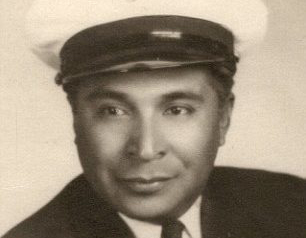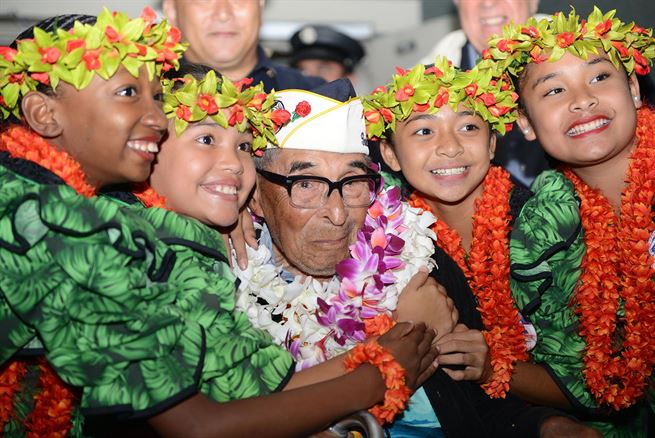
redo Jump to...
print Print...
(by Steven Luke and Monica Garske, NBCSanDiego7) – A 104-year-old San Diego resident known as the oldest survivor of Pearl Harbor boarded a flight to Honolulu Saturday, where he will be honored at a ceremony.
Ray Chavez, who lives in Poway, California, will serve as a special guest of the 75th anniversary commemorative ceremonies on Dec. 7. Seaman 1st Class Chavez was assigned to the USS Condor. On Dec. 7, 1941, he was asleep at home after a minesweeping mission during which his crew helped in sinking an enemy submarine. His wife woke him up with word of the attack on Pearl Harbor.
Chavez raced to the burning Pearl Harbor and did not leave for a week. Today, he is the oldest known living U.S. military veteran of the bombing raid that killed thousands and sparked WWII.
“I never will forget [Pearl Harbor] as long as I live,” Chavez said before boarding his flight at the San Diego International Airport Saturday.
Alaska Airlines flew Chavez and his daughter, Kathleen – a retired U.S. Navy veteran – first class.
“He’s the oldest, and there’s not too many of them left anymore,” his daughter said.

Ray Chavez poses for a photo at the Honolulu International Airport, Dec. 3, 2016. More than 100 World War II veterans, including Pearl Harbor survivors, arrived to Honolulu to participate in the remembrance events throughout the week to honor the courage and sacrifices of those who served during Dec. 7, 1941, and throughout the Pacific Theater. Dec. 7, 2016, marks the 75th anniversary of the attacks on Pearl Harbor and Oahu. (Photo: Petty Officer 2nd Class Tara Mol / U.S. Pacific Command)
San Diego firefighter Mitch Mendler and retired New York firefighter Joe Torillo, who survived the 9/11 attacks, accompanied Chavez on the flight as honorary escorts.
A special TSA line awaited Chavez at the airport, giving him his screening. And, as he made his way to his gate, stranger after stranger stopped him to take photos with him, shake his hand and thank him for his service.
Chavez said he’s humbled by the attention.
“Well, I’m not exactly a hero, because there were thousands of other heroes, too. But I’m very proud of the honor bestowed on me,” he added.
Reprinted here for educational purposes only. May not be reproduced on other websites without permission from NBC San Diego 7. Visit the website at nbcsandiego .com.
Questions
1. The first paragraph of a news article should answer the questions who, what, where and when. List the who, what, where and when of this news item. (NOTE: The remainder of a news article provides details on the why and/or how.)
2. a) What rank was Ray Chavez on Dec. 7, 1941?
b) On what ship was he assigned?
c) How long did Chavez spend at the port after the attack?
3. Answer the following questions about Pearl Harbor:
a) How many U.S. battleships were at Pearl Harbor when the Japanese attacked?
b) How many of these battleships were sunk?
c) How many other vessels were sunk?
d) How many U.S. aircraft were destroyed?
e) How many American military personnel were killed? – How many were wounded?
f) Who was president when Pearl Harbor was attacked? How did he refer to the attack on Pearl Harbor when requesting Congress to declare war the next day?
4. Today’s Daily News Article is a human interest news story. Human interest stories differ from the regular news – they are sometimes referred to as “the story behind the story.“ The major news articles of the day tell of important happenings. Human interest stories tell of how those happenings have impacted the people or places around the story.
Seventy five years after the Japanese attack on Pearl Harbor, do you think this human interest story is newsworthy? Why or why not?
5. What 2 adjectives do you think best describe Ray Chavez? Explain your answer.
6. What inspires you most about Mr. Chavez?
Background
THE ATTACK ON PEARL HARBOR The attack on Pearl Harbor was a surprise military strike conducted by the Imperial Japanese Navy against the United States naval base at Pearl Harbor, Hawaii on the morning of December 7, 1941.
- The base was attacked by 353 Japanese aircraft in two waves, launched from six aircraft carriers.
- Four U.S. Navy battleships were sunk (two of which were raised and returned to service later in the war) and the four other battleships present were damaged*
- The Japanese also sank or damaged three cruisers, three destroyers, an anti-aircraft training ship and one minelayer.
- 188 U.S. aircraft were destroyed, 2,402 personnel were killed and 1,282 were wounded.
- The power station, shipyard, maintenance, and fuel and torpedo storage facilities, as well as the submarine piers and headquarters building (also home of the intelligence section) were not attacked.
- Japanese losses were light, with 29 aircraft and five midget submarines lost, and 65 servicemen killed or wounded. One Japanese sailor was captured.
- The following day (December 8) the United States declared war on Japan.
- Subsequent operations by the U.S., as well as the Axis alliance, prompted Germany and Italy to declare war on the U.S. on December 11, which was reciprocated by the U.S. the same day.
- Despite numerous historical precedents for unannounced military action, the lack of any formal warning by Japan, particularly while negotiations were still apparently ongoing, led to President Franklin D. Roosevelt proclaiming December 7, 1941, “a date which will live in infamy.” (exerpted from wikipedia)
*About the Battleships:
- USS Arizona (Kidd’s flagship): hit by four armor-piercing bombs, exploded; total loss. 1,177 dead.
- USS Oklahoma: hit by five torpedoes, capsized; total loss. 429 dead. Refloated November 1943; capsized and lost while under tow to the mainland May 1947.
- USS West Virginia: hit by two bombs, seven torpedoes, sunk; returned to service July 1944. 106 dead.
- USS California: hit by two bombs, two torpedoes, sunk; returned to service January 1944. 100 dead.
- USS Nevada: hit by six bombs, one torpedo, beached; returned to service October 1942. 60 dead.
- USS Tennessee: hit by two bombs; returned to service February 1942. 5 dead.
- USS Maryland: hit by two bombs; returned to service February 1942. 4 dead (including floatplane pilot shot down).
- USS Pennsylvania (Kimmel’s flagship):[111] in drydock with Cassin and Downes, hit by one bomb, debris from USS Cassin; remained in service. 9 dead.
In a speech Dec. 8, 1941 asking Congress to declare war on Japan after the bombing of Pearl Harbor, President Franklin D. Rooselvelt said in part:
“Yesterday, December 7, 1941 – a date which will live in infamy – the United States of America was suddenly and deliberately attacked by naval and air forces of the Empire of Japan… No matter how long it may take us to overcome this premeditated invasion, the American people will through their righteous might win through to absolute victory… With confidence in our armed forces – with the unbounded determination of our people – we will gain the inevitable triumph – so help us God. I, therefore, ask that the Congress declare that since the dastardly and unprovoked attack by Japan on Sunday, December 7th, a state of war has existed between the United States and the Japanese Empire.”
-Read FDR’s speech to Congress at fdrlibrary.marist.edu, OR
-Listen to FDR’s speech to Congress at history.com.
Resources
Watch two news reports on Mr. Chavez’s trip to Pearl Harbor this year:
Video #2:
Watch a March 2016 news report about Ray Chavez working out at a gym:
Daily “Answers” emails are provided for Daily News Articles, Tuesday’s World Events and Friday’s News Quiz.



